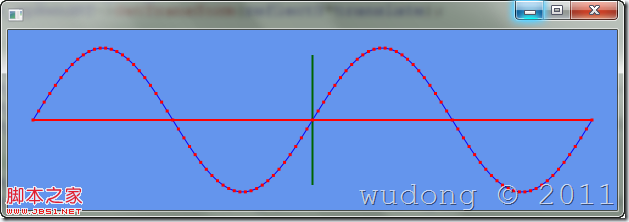Direct2D通過
ID2D1RenderTarget接口支持基本圖元(直線,矩形,圓角矩形,橢圓等)的繪制,然而,此接口並未提供對曲線繪制的直接支持。因此,想要使用Direct2D繪制一段通過指定點的曲線,比如Bezier曲線,必須借助於
DrawGeometry()方法間接實現。需要通過一定的算法,將指定點轉換為定義Path的控制點。幸運的是,codproject上已經有人做了這項工作,給出了相應的轉換算法,並給出了C#版的實現:
Draw a Smooth Curve through a Set of 2D Points with Bezier Primitives
C#的代碼可以很容易的轉換成C++版本的,下面是我轉換的一個用於Direct2D的繪制Bezier曲線的C++函數:
代碼如下:
/// <summary>
/// Refer to : http://www.codeproject.com/KB/graphics/BezierSpline.aspx
/// Solves a tridiagonal system for one of coordinates (x or y) of first Bezier control points.
/// </summary>
/// <param name="rhs">Right hand side vector.</param>
/// <param name="x">Solution vector.</param>
void GetFirstControlPoints(
__in const std::vector<FLOAT>& rhs,
__out std::vector<FLOAT>& x )
{
ATLASSERT(rhs.size()==x.size());
int n = rhs.size();
std::vector<FLOAT> tmp(n); // Temp workspace.
FLOAT b = 2.0f;
x[0] = rhs[0] / b;
for (int i = 1; i < n; i++) // Decomposition and forward substitution.
{
tmp[i] = 1 / b;
b = (i < n-1 ? 4.0f : 3.5f) - tmp[i];
x[i] = (rhs[i] - x[i-1]) / b;
}
for (int i = 1; i < n; i++)
{
x[n-i-1] -= tmp[n-i] * x[n-i]; // Back substitution.
}
}
/// <summary>
/// Refer to : http://www.codeproject.com/KB/graphics/BezierSpline.aspx
/// Get open-ended Bezier Spline Control Points.
/// </summary>
/// <param name="knots">Input Knot Bezier spline points.</param>
/// <param name="firstCtrlPt">Output First Control points array of knots.size()-1 length.</param>
/// <param name="secondCtrlPt">Output Second Control points array of knots.size()-1 length.</param>
void GetCurveControlPoints(
__in const std::vector<D2D1_POINT_2F>& knots,
__out std::vector<D2D1_POINT_2F>& firstCtrlPt,
__out std::vector<D2D1_POINT_2F>& secondCtrlPt )
{
ATLASSERT( (firstCtrlPt.size()==secondCtrlPt.size())
&& (knots.size()==firstCtrlPt.size()+1) );
int n = knots.size()-1;
ATLASSERT(n>=1);
if (n == 1)
{
// Special case: Bezier curve should be a straight line.
// 3P1 = 2P0 + P3
firstCtrlPt[0].x = (2 * knots[0].x + knots[1].x) / 3.0f;
firstCtrlPt[0].y = (2 * knots[0].y + knots[1].y) / 3.0f;
// P2 = 2P1 – P0
secondCtrlPt[0].x = 2 * firstCtrlPt[0].x - knots[0].x;
secondCtrlPt[0].y = 2 * firstCtrlPt[0].y - knots[0].y;
return;
}
// Calculate first Bezier control points
// Right hand side vector
std::vector<FLOAT> rhs(n);
// Set right hand side X values
for (int i = 1; i < (n-1); ++i)
{
rhs[i] = 4 * knots[i].x + 2 * knots[i+1].x;
}
rhs[0] = knots[0].x + 2 * knots[1].x;
rhs[n-1] = (8 * knots[n-1].x + knots[n].x) / 2.0f;
// Get first control points X-values
std::vector<FLOAT> x(n);
GetFirstControlPoints(rhs,x);
// Set right hand side Y values
for (int i = 1; i < (n-1); ++i)
{
rhs[i] = 4 * knots[i].y + 2 * knots[i+1].y;
}
rhs[0] = knots[0].y + 2 * knots[1].y;
rhs[n-1] = (8 * knots[n-1].y + knots[n].y) / 2.0f;
// Get first control points Y-values
std::vector<FLOAT> y(n);
GetFirstControlPoints(rhs,y);
// Fill output arrays.
for (int i = 0; i < n; ++i)
{
// First control point
firstCtrlPt[i] = D2D1::Point2F(x[i],y[i]);
// Second control point
if (i < (n-1))
{
secondCtrlPt[i] = D2D1::Point2F(2 * knots[i+1].x - x[i+1], 2*knots[i+1].y-y[i+1]);
}
else
{
secondCtrlPt[i] = D2D1::Point2F((knots[n].x + x[n-1])/2, (knots[n].y+y[n-1])/2);
}
}
}
HRESULT CreateBezierSpline(
__in ID2D1Factory* pD2dFactory,
__in const std::vector<D2D1_POINT_2F>& points,
__out ID2D1PathGeometry** ppPathGeometry )
{
CHECK_PTR(pD2dFactory);
CHECK_OUTPUT_PTR(ppPathGeometry);
ATLASSERT(points.size()>1);
int n = points.size();
std::vector<D2D1_POINT_2F> firstCtrlPt(n-1);
std::vector<D2D1_POINT_2F> secondCtrlPt(n-1);
GetCurveControlPoints(points,firstCtrlPt,secondCtrlPt);
HRESULT hr = pD2dFactory->CreatePathGeometry(ppPathGeometry);
CHECKHR(hr);
if (FAILED(hr))
return hr;
CComPtr<ID2D1GeometrySink> spSink;
hr = (*ppPathGeometry)->Open(&spSink);
CHECKHR(hr);
if (SUCCEEDED(hr))
{
spSink->SetFillMode(D2D1_FILL_MODE_WINDING);
spSink->BeginFigure(points[0],D2D1_FIGURE_BEGIN_FILLED);
for (int i=1;i<n;i++)
spSink->AddBezier(D2D1::BezierSegment(firstCtrlPt[i-1],secondCtrlPt[i-1],points[i]));
spSink->EndFigure(D2D1_FIGURE_END_OPEN);
spSink->Close();
}
return hr;
}
下面是一個使用此函數繪制正弦函數的Sample,曲線的紅點是曲線的控制點:
代碼如下:
#pragma once
#include "stdafx.h"
#include <Direct2DHelper.h>
using D2D1::Point2F;
using D2D1::SizeU;
using D2D1::ColorF;
using D2D1::Matrix3x2F;
using D2D1::BezierSegment;
using D2D1::RectF;
#include <vector>
using std::vector;
#include <algorithm>
#include <boost/math/distributions/normal.hpp>
class CMainWindow :
public CWindowImpl<CMainWindow,CWindow,CSimpleWinTraits>
{
public:
BEGIN_MSG_MAP(CMainWindow)
MSG_WM_PAINT(OnPaint)
MSG_WM_ERASEBKGND(OnEraseBkgnd)
MSG_WM_SIZE(OnSize)
MSG_WM_CREATE(OnCreate)
MSG_WM_DESTROY(OnDestroy)
END_MSG_MAP()
int OnCreate(LPCREATESTRUCT /*lpCreateStruct*/)
{
CreateDeviceIndependentResource();
CreateDeviceResource();
CreateCurve();
return 0;
}
void OnDestroy()
{
PostQuitMessage(0);
}
void OnPaint(CDCHandle)
{
CPaintDC dc(m_hWnd);
Render();
}
BOOL OnEraseBkgnd(CDCHandle dc)
{
return TRUE; // we have erased the background
}
void OnSize(UINT /*nType*/, CSize size)
{
if (m_spHwndRT)
{
m_spHwndRT->Resize(SizeU(size.cx,size.cy));
CreateCurve();
}
}
private:
void Render()
{
if (!m_spHwndRT)
CreateDeviceResource();
m_spHwndRT->BeginDraw();
m_spHwndRT->Clear(ColorF(ColorF::CornflowerBlue));
m_spHwndRT->SetTransform(Matrix3x2F::Identity());
D2D1_SIZE_F size = m_spHwndRT->GetSize();
FLOAT width = size.width-50, height = size.height-50;
D2D1_MATRIX_3X2_F reflectY = Direct2DHelper::ReflectYMatrix();
D2D1_MATRIX_3X2_F translate = Matrix3x2F::Translation(size.width/2.0f,size.height/2.0f);
m_spHwndRT->SetTransform(reflectY*translate);
// draw coordinate axis
m_spSolidBrush->SetColor(ColorF(ColorF::Red));
m_spHwndRT->DrawLine(Point2F(-width*0.5f,0),Point2F(width*0.5f,0),m_spSolidBrush,2.0f);
m_spSolidBrush->SetColor(ColorF(ColorF::DarkGreen));
m_spHwndRT->DrawLine(Point2F(0,-height*0.5f),Point2F(0,height*0.5f),m_spSolidBrush,2.0f);
// draw curve
m_spSolidBrush->SetColor(ColorF(ColorF::Blue));
m_spHwndRT->DrawGeometry(m_spPathGeometry,m_spSolidBrush,1.0f);
// draw point marks
m_spSolidBrush->SetColor(ColorF(ColorF::Red));
for (auto p=m_Points.cbegin();p!=m_Points.cend();p++)
{
Direct2DHelper::DrawRectPoint(m_spHwndRT,m_spSolidBrush,(*p),5.0f);
}
HRESULT hr = m_spHwndRT->EndDraw();
if (hr == D2DERR_RECREATE_TARGET)
DiscardDeviceResource();
}
void CreateDeviceIndependentResource()
{
Direct2DHelper::CreateD2D1Factory(&m_spD2dFactory);
}
void CreateDeviceResource()
{
CRect rc;
GetClientRect(&rc);
CHECK_PTR(m_spD2dFactory);
IFR(m_spD2dFactory->CreateHwndRenderTarget(
D2D1::RenderTargetProperties(),
D2D1::HwndRenderTargetProperties(m_hWnd,SizeU(rc.Width(),rc.Height())),
&m_spHwndRT));
IFR(m_spHwndRT->CreateSolidColorBrush(ColorF(ColorF::Red),&m_spSolidBrush));
}
void DiscardDeviceResource()
{
m_spSolidBrush.Release();
m_spHwndRT.Release();
}
void CreateCurve()
{
if (!m_spHwndRT)
return;
if (m_spPathGeometry)
{
m_spPathGeometry.Release();
m_Points.clear();
}
const int ptCount = 100;
D2D1_SIZE_F size = m_spHwndRT->GetSize();
FLOAT width = size.width-50.0f, height = size.height*0.4f;
#define SIN_CURVE
#ifdef SIN_CURVE // create sin curve
FLOAT factor = static_cast<FLOAT>(4.0f*M_PI/width);
FLOAT x = -width*0.5f, y = 0, dx = width/ptCount;
for (int i=0;i<ptCount+1;i++)
{
y = height*sin(factor*x);
m_Points.push_back(Point2F(x,y));
x += dx;
}
#else // create normal distribute curve
FLOAT factor = 10.0f/width;
FLOAT x = -width*0.5f, y = 0, dx = width/ptCount;
boost::math::normal nd;
for (int i=0;i<ptCount+1;i++)
{
y = height*static_cast<FLOAT>(boost::math::pdf(nd,factor*x));
m_Points.push_back(Point2F(x,y));
x += dx;
}
#endif // SIN_CURVE
// create Bezier spline
Direct2DHelper::CreateBezierSpline(m_spD2dFactory,m_Points,&m_spPathGeometry);
CHECK_PTR(m_spPathGeometry);
}
private:
CComPtr<ID2D1Factory> m_spD2dFactory;
CComPtr<ID2D1HwndRenderTarget> m_spHwndRT;
CComPtr<ID2D1SolidColorBrush> m_spSolidBrush;
CComPtr<ID2D1PathGeometry> m_spPathGeometry;
vector<D2D1_POINT_2F> m_Points;
};

